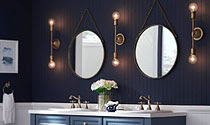The Beauty of Alabaster Lighting
Praised for its glamour and natural beauty, alabaster refers to the soft, smooth, fine-grained sedimentary gypsum rock. Deposits of alabaster are found in various countries across the globe, including Italy, Spain and America. Historically, alabaster was predominately used to create sculptures and small ornate carvings. Now, alabaster is most often used in the creation of light fixtures, such as chandeliers, pendants, and wall scones.
Click here to get more info about:shop ceiling fans
Alabaster is quarried in large, open pits and is found approximately 12-20 feet below the surface. These rocks are typically between 15-20” in height and nearly 2-3 feet in diameter. After the alabaster is removed from the quarry, the rock is taken to a sawmill and cut into flat, round pieces. When sliced into 1-2 inch thick pieces, light is able to pass through the rock.
Every piece of alabaster will differ in color, opacity and veining. Therefore, no two alabaster pieces are identical, meaning each alabaster fixture is a unique, exclusive piece of art.
Perfect for both residential and commercial use, alabaster is one of the most desirable stones used for lighting. However, this does not come without a cost. Due to the high cost of quarrying alabaster it tends to be a bit more expensive than traditional lighting forms. Alabaster is also incredibly delicate to extract, which contributes to this heighted cost.
Due to the delicate nature of alabaster, cleaning and treatment is very specific. We recommend never using detergents or potentially harmful abrasives. Instead, we suggest that you opt for a slight damp cloth and gently wipe the light down.
For more information visit:modern bathroom lighting
Due to the popularity and costly nature of alabaster, many brands have begun to create imitation alabaster but market it as the real deal. When examining the product, look at the thickness, weight, and veining of the stone. Legitimate alabaster is typically at least ⅜-inch thick and is quite heavy in weight. The stone should also have translucent veins. If you notice that two “alabaster” lights have the same veining pattern located in the same place, it is imitation alabaster.
At the Lighting Shoppe, our alabaster products are made with 100 percent genuine stone.



Comments
Post a Comment